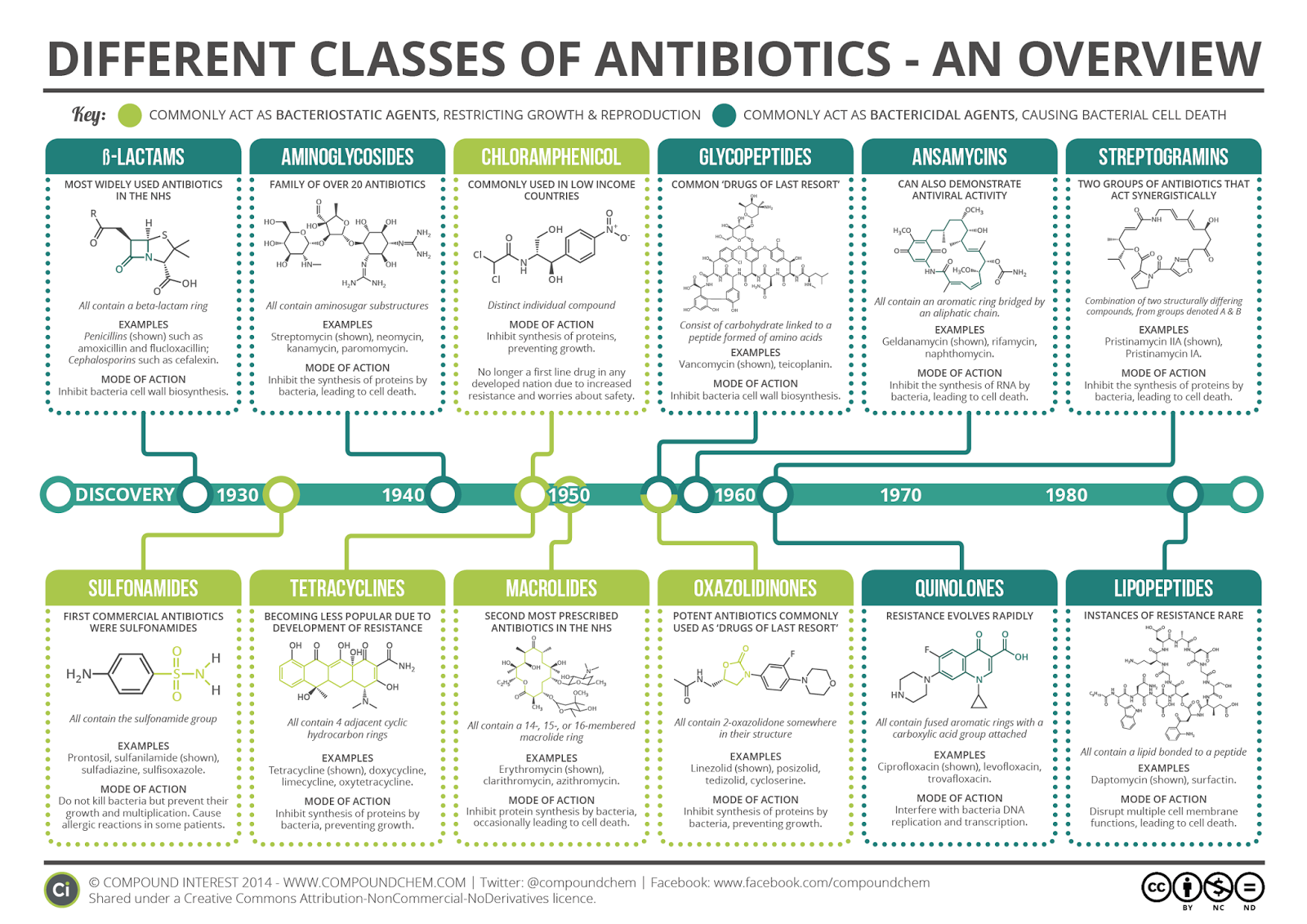An antibiotic is an agent that either kills or inhibits the growth of a microorganism. This useful infographic outlines some of the major categories of antibiotics available.
 |
| Antibiotic classification chart |
The successful outcome of antimicrobial therapy with antibacterial compounds depends on several factors. These include host defense mechanisms, the location of infection, and the pharmacokinetic and pharmacodynamic properties of the antibacterial. A bactericidal activity of antibacterials may depend on the bacterial growth phase, and it often requires ongoing metabolic activity and division of bacterial cells.

Antibacterial antibiotics are commonly classified based on their mechanism of action, chemical structure, or spectrum of activity. Most target bacterial functions or growth processes. Those that target the bacterial cell wall (penicillins and cephalosporins) or the cell membrane (polymyxins), or interfere with essential bacterial enzymes (rifamycins, lipiarmycins, quinolones, and sulfonamides) have bactericidal activities. Those that target protein synthesis (macrolides,lincosamides and tetracyclines) are usually
bacteriostatic (with the exception of bactericidal aminoglycosides).
Classification of antibiotics on the basis of chemical structure:

- Carbohydrate containing Antibiotics:
- Pure saccharides antibiotics: examples; Streptozotocin
- Aminoglycosides: examples; Streptomycin
- N/O glycosides: eg. Chromomycin
- Other: eg; Lincomycin
- Macrocyclic lactone antibiotics: eg. Erythromycin
- Quinolones antibiotics; eg. Fluroquinolone
- N-containing heterocyclic antibiotics: eg. Beta-lactum
- O-containing heterocyclic antibiotics: eg. Cycloserine
- Alicyclic antibiotics: eg. Cycloheximide
- Aromatic antibiotics (Nitrobenzene): eg. Chloramphenicol
- Aliphatic amine antibiotics: eg. Spermidine
- Peptide antibiotics: eg. Polymyxin, Bacitracin, Gramicidin
Classification of antibiotics on the basis of origin:
Microbial origin:
- Bacillus polymyxa: Polymyxin
- Chromobacter violaceum: Bacitracin
- Micromonospora spp: Gentamycin
- Penicillium notatum: Penicillin
- Cephalosporin spp: Cephalosporin
- Streptomyces griseus: Streptomycin
- S. venezuelue: Chloramphenicol
- S. erythreus: Erythromycin
- S. mediterranae: Rifampicin

Further categorization is based on their target specificity. "Narrow-spectrum" antibacterial antibiotics target specific types of bacteria, such as Gram-negative or Gram-positive bacteria, whereas broad-spectrum antibiotics affect a wide range of bacteria. Following a 40-year hiatus in discovering new classes of antibacterial compounds, four new classes of antibacterial antibiotics have been brought into clinical use: cyclic lipopeptides (such as daptomycin), glycylcyclines (such as tigecycline), oxazolidinones (such aslinezolid), and lipiarmycins (such as fidaxomicin).
Classification of antibiotics on the basis of range of activity (spectrum of activity):1.Narrow spectrum:
Active towards relatively fewer microorganisms.
Examples: macrolides, Polymyxin
2. Moderate spectrum:
Active towards Gram Positive bacteria as well as some systemic and UTI causing Gram negative bacteria.
Examples: Aminoglycosides, Sulfonamide
3. Narrow-Broad spectrum:
Active against Gram positive and gram negative
Examples: Beta-lactum
4. Broad spectrum:
Active against Gram positive and Gram negative except Pseudomonas and Mycobacteria.
Examples: Chloramphenicol, Tetracycline
5. Anti-mycobacterial antibiotics:
Examples: Ethambutol, Rifampicin, Isoniazid, Pyrazinamide
Classification on the mode of action
Protein synthesis inhibitorsMajor groups: aminoglycosides, tetracyclines, macrolides
General mechanism of action: Protein synthesis inhibiting antibiotics primarily target the bacterial ribosome (70S) which is made up of a small, 30S subunit and a large, 50S subunit. A ribosome is an essential, complex molecule made up of proteins and RNA and is responsible for synthesizing proteins. Aminoglycosides, macrolides, and other protein synthesis inhibitors target and prevent specific stages of protein synthesis at specific locations on 70S ribosomes. Bacterial death occurs because the cell cannot make proteins required for essential cellular processes.
Effects on humans – Humans, and other eukaryotic cells synthesize proteins using a 80S (not 70S) ribosome which is not targeted by these inhibitors. (other side effects are possible).
Nucleic acid synthesis inhibitors
Major groups: Antifolates, topoisomerase inhibitors (floroquinolones)
General mechanism of action: These antibiotics target different stages and pathways of nucleic acid (DNA, RNA…) synthesis. In summary, antifolates (includes sulfonamides) inhibit enzymes involved in folate/folic acid (vitamin B9) synthesis. Folate is an essential ingredient for the synthesis of pyrimidine and purines, two molecules found in nucleotides, the building blocks of DNA and other nucleic acids. Topoisomerase inhibitors prevent DNA replication by inhibiting topoisomerase activity. Toposiomerases are enzymes that relieve DNA supercoil stress during DNA replication. By inhibiting topoisomerase activity, DNA replication is greatly hindered and cell division rate is diminished.
Effects on humans – Humans acquire folate from dietary sources, they do not have a synthesis pathway for folate and are not affected by antifolates in the same way bacteria are. Topoisomerases can be found in human cells; however the molecular makeup of human topoisomerases differs from those found in bacteria. (other side effects are possible).
Cell wall synthesis inhibitors
Major groups: Beta-lactams (cephalosporins, penicillins)
General mechanism of action: As the name implies, this group of antibiotics inhibits certain stages in bacterial cell wall synthesis. A major structural component in the bacterial cell wall (more so in Gram-positive bacteria) is an essential polymer called peptidoglycan. Beta-lactam antibiotics bind to PBPs or penicillin binding proteins which are involved in the final stages of peptidoglycan synthesis. By inhibiting PBP function, peptidoglycan cannot be properly synthesized and the cell lyses.
Effects on humans – Human cells do not use nor synthesize peptidoglycan and are therefore not susceptible to beta-lactam antibiotics. (other side effects are possible).
Classification of antibiotics on the basis of effects of their activity:
1. Bactericidal:
Kills bacteria
Examples: Aminoglycosides, Penicillin, Cephalosporin.
2. Bacteriostatic:
Inhibits the growth of bacteria
Examples: Sulfonamide, tetracycline, chloramphenicol, trimethoprim, macrolides, Lincosamide.
Classification of antibiotics on the basis of Route of administration:
1. Oral antibiotics:
Acid stable antibiotics,
Examples; Penicillin V
2. Parenteral route:












